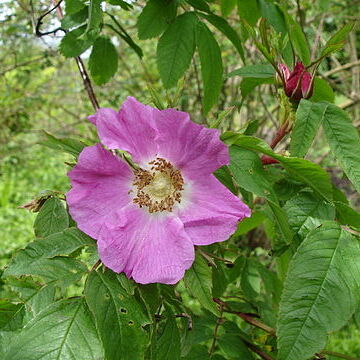Shrubs 1–3 m tall. Branchlets terete, slender; prickles scattered, terete, straight or slightly curved, to 1 cm, abruptly tapering to base; old branches often densely bristly. Leaves including petiole 4–11 cm; stipules broad, mostly adnate to petiole, free parts ovate, glabrous, margin glandular serrate, apex acute; rachis and petiole glabrous or sparsely pubescent, prickly, or sparsely glandular and shortly prickly; leaflets 7–9, rarely 5; elliptic, ovate, or oblong, 1–3 × 0.6–2 cm, glabrous or abaxially along veins sparsely pubescent and glandular-pubescent, base subrounded, margin simply serrate, apex acute or rounded-obtuse. Flowers solitary, or 2 or 3 and fasciculate, 2–5 cm in diam.; pedicel 5–10 mm, stipitate glandular-pubescent or not; bracts ovate-lanceolate, glabrous, margin glandular serrate, apex acuminate. Hypanthium ellipsoid-ovoid. Sepals 5, ovate-lanceolate, leaflike, abaxially stipitate glandular, adaxially densely pubescent, margin entire. Petals 5, pink, obovate, base cuneate, apex emarginate. Styles free, much shorter than stamens, densely villous. Hip deep red, ellipsoid-ovoid, 1–1.5 cm in diam., with a short neck at apex, stipitate glandular or not, with persistent sepals. Fl. May–Jul, fr. Aug–Oct.
More
A shrub. It grows 2-3 m high. The branches have straight prickles. The leaves have leaflets along the stalk. There are 7-9 leaflets. These are narrowly oval and 1-3 cm long. There are teeth along the edge. The flowers are bright red. There are 1-3 in a cluster and they are 4-5 cm across.
Can be grown by cuttings or seedlings. Seeds needs scarification.

